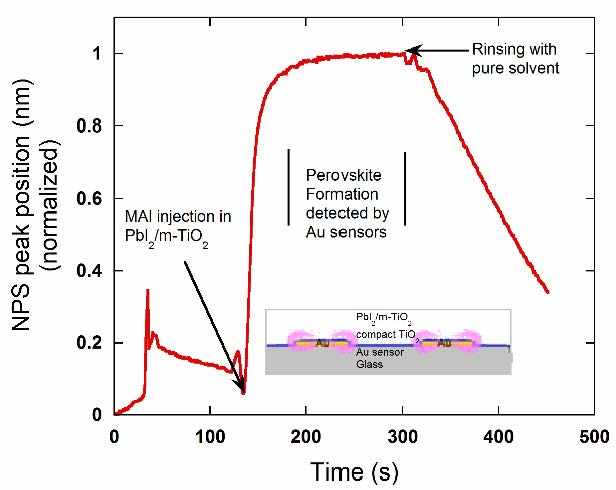Article
Version 1
Preserved in Portico This version is not peer-reviewed
Nanoplasmonic Sensing of CH3NH3PbI3 Perovskite Formation in Mimic of Solar Cell Photoelectrodes
Version 1
: Received: 6 September 2018 / Approved: 7 September 2018 / Online: 7 September 2018 (03:38:22 CEST)
Version 2 : Received: 10 September 2018 / Approved: 11 September 2018 / Online: 11 September 2018 (05:10:40 CEST)
Version 2 : Received: 10 September 2018 / Approved: 11 September 2018 / Online: 11 September 2018 (05:10:40 CEST)
How to cite: Rajab, F. M. Nanoplasmonic Sensing of CH3NH3PbI3 Perovskite Formation in Mimic of Solar Cell Photoelectrodes. Preprints 2018, 2018090124. https://doi.org/10.20944/preprints201809.0124.v1 Rajab, F. M. Nanoplasmonic Sensing of CH3NH3PbI3 Perovskite Formation in Mimic of Solar Cell Photoelectrodes. Preprints 2018, 2018090124. https://doi.org/10.20944/preprints201809.0124.v1
Abstract
The formation of methylammonium lead iodide (CH3NH3PbI3) perovskite into mesoporous titania (TiO2) scaffold via a sequential deposition method is known to offer high quality films for good photovoltaic device performance. The growth reactions at the mesoporous TiO2 film depend on reactants concentration in the host matrix and the reaction activation energy. Here, we have used a NanoPlasmonic Sensing (NPS) approach with gold (Au) nanosensors to monitor the formation of CH3NH3PbI3 perovskite at the lower interface of 350 nm mesoporous TiO2, typical thickness used in a photovoltaic device. This technique provides time-resolved spectral shifts of the localized surface plasmon resonance at different operating temperatures and methylammonium iodide (CH3NH3I3) concentrations by recording changes in the local vicinity of the Au nanosensors at the mesoporous TiO2 film interface. Analytical studies included Ellipsometry, Scanning Electron Microscopy, and X-ray diffraction. The results show that perovskite conversion can be obtained at lower CH3NH3I3 concentrations if reaction activation energy is lowered. A significant finding is that the NPS response at 350 nm mesoporous TiO2 can widely change from red shifts to blue shifts depending on extent of conversion and morphology of perovskite formed at given reaction conditions.
Keywords
nanoplasmonic sensing spectroscopy; CH3NH3PbI3 perovskite; mesoporous TiO2; gold nanosensor
Subject
Chemistry and Materials Science, Nanotechnology
Copyright: This is an open access article distributed under the Creative Commons Attribution License which permits unrestricted use, distribution, and reproduction in any medium, provided the original work is properly cited.
Comments (0)
We encourage comments and feedback from a broad range of readers. See criteria for comments and our Diversity statement.
Leave a public commentSend a private comment to the author(s)
* All users must log in before leaving a comment







